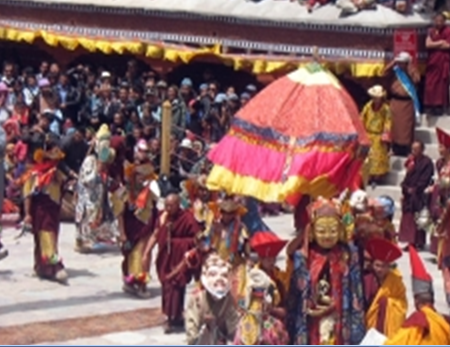Hemis
(Created page with "{| class="wikitable" |- |colspan="0"|<div style="font-size:100%"> This is a collection of articles archived for the excellence of their content.<br/>You can help by converting...") |
Revision as of 19:06, 5 December 2013
This is a collection of articles archived for the excellence of their content. Readers will be able to edit existing articles and post new articles directly |
Contents |
Hemis
Hemis Tsechu
Ladakh commemorates the birth of Guru Padmasambhava
Hemis Tsechu celebrated
By Rinchen Angmo Chumikchan,
Friday, June 28, 2013
Hemis: The Hemis Gompa was re-established in 1672 by the Ladakhi king Sengge Namgyal. The gompa, which is known to be the wealthiest and the biggest in Ladakh, also features the largest Thangka in Ladakh. Till 17th century this monastery was known as Chang Chub Sam Ling or "the lone place of the compassionate person", and after 17th century it is known as ‘Sang Naag Chos Ling’.
The Hemis Festival of Ladakh is a major crowd puller and holds a lot of significance in terms of culture and religion. The festival, which runs for two days, is celebrated to mark the birth anniversary of the Guru Padmasambhava (Guru Rinpoche). Guru Padmasambhava, the founder of Tibetan Buddhism, fought with evils to protect his people. He spread Buddhism in Tibet and spread the message of spiritual harmony and intellectual prosperity among all human beings.
Guru Rinpoche/ Guru Padmasambhava
It is regarded that the birthday of Guru Rinpoche was predicted by Sakya Muni Buddha himself. Buddha said, “After my parinama (Death) After ten and two years, In the land of Udiyana A man called Padmasambhava Will come, who will be better than me.” Just according to the prediction, a child was born in a lotus flower, in a milky lake, in Udiyana without parents. Thus Padmasambhava was born miraculously on 10th of 5th month in a Monkey Year. He had the major and minor noble marks on his body which was insatiable for the people to look at. Emitting immense light he preached the Vajrayana teachings to Dakinis in Udiyana. Khampo Tsewang Rigzin said, “Between the years 1191-1274 the great sage Rgodshangpa Mgonpo Rdor Rje came to Ladakh and established the tradition of ‘Brugpa School’. He meditated in the upper part of Hemis gorge in a cave which became famous as ‘Rgod-Tshang’ from his own name. After that Lama Stagtsang Raspa and the King Senge Namgyal (about 1590-1620) founded the Hemis monastery. About the year 1730, Rgyalsras Rinpoche, the third incarnate of Stagtsang made an all round development of Hemis. The number of monks increased. He initiated the annual Wangchhog fair both at Hemis and Chemray monasteries and the famous Hemis Fair at Hemis. From that time the fair has been observed continuously and now has become known in the whole world.” The two-day festivity is marked by prayers and the display of ancient Thangka (religious painting), which is the oldest treasure housed at Hemis. Throughout the fair, mask dance are performed by monks.
Hemis Tsechu
The Hemis Tsechu is observed on the 9th to 11th, that is, for three days. Especially, we have the monkey year fair once in a cycle of 12 years. One of the most sacred objects to see in that year is the four storeys Thanka painting of Guru Padmasambhava. This is exhibited once in the 10th of 5th month in the Monkey year in a cycle of 12 years. This is a marvellous painting, a patched work of silk cloth of various colours. This was prepared in between 1750-1760 by Rgyalsras Mipham Tsewang, the third incarnate of Stagtsang Raspa said, Khampo Tsewang Rigzin. During Hemis fair, shopkeepers and hawkers set up stalls outside the monastery, selling a huge range of wares which caters to the crowds of tourists coming to witness and enjoy the festival. It brings an opportunity for all the villagers and families to come together and socialise. The two days fair of Hemis Gompa witness the great zeal and enjoyment among the devotees who gather from corners of India and abroad at the courtyard of Hemis monastery.
